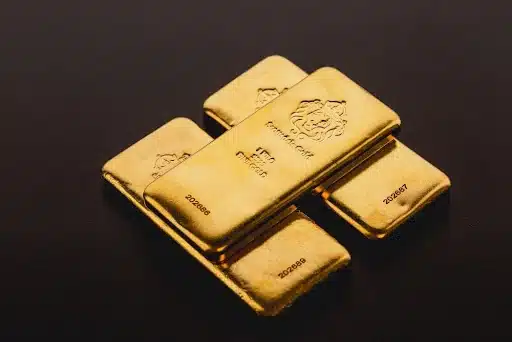How much does a bar of gold weigh?
The weight of a gold bar according to its size
Gold bullion is refined gold in bar form. The precious metal is melted down and reconditioned into ingots, partly through the recycling of jewelry, objects and electronic parts. A distinction is made between gold bars intended for storage and the manufacture of new jewelry and components, and those intended for investment. The weight of a gold ingot varies according to its size and therefore its gold concentration. Find out more in this article!
- 1 gram of gold = 0.0321507465 ounce of gold
- 1 kilo of gold = 32.1507465 ounces of gold
- 1 tonne of gold = 32,150.70 ounces of gold
- 1 ounce of gold = 31.1034768 grams of gold or 0.0311034768 kilo of gold
But don’t worry: when you buy gold bullion, the seller will make this conversion and tell you the current value of your bar.
- 1 gram of gold = 0.0321507465 ounce of gold
- 1 kilo of gold = 32.1507465 ounces of gold
- 1 tonne of gold = 32,150.70 ounces of gold
- 1 ounce of gold = 31.1034768 grams of gold or 0.0311034768 kilo of gold
But don’t worry: when you buy gold bullion, the seller will make this conversion and tell you the current value of your bar.
Before making your first investment in ingots, you should know that there are around thirty different types. You can buy them on the precious metals market, in a specialized agency such as Les Métaux Précieux. Les gold bars 1kg are the most common. It is the most popular with a purity of 999.9/1000.
The price and value of ingots then vary according to their weight (which varies from smelter to smelter) and gram. The most traditional weights found are :
- 500-gram gold ingot
- 250 gram gold ingot
- 100 gram gold ingot
But there are no fewer than 400 different types! And the world’s heaviest gold bar weighs 250 kg.
All gold ingots must have a titre greater than or equal to 995 ‰ with explicit indication of the weight. This level is the minimum purity that gold bullion manufacturers are obliged to meet in order to be certified by the LBMA (London Bullion Market Association) standard. Each bar has a serial number and a test report (certificate) in good order and without erasures, mentioning the same serial number.
In 2010, a new range of ingots (mini gold bars) was launched. The weight of a gold ingot now varies from 50, 25, 10 or 5 grams. There are even “micro-lingots” weighing just 1 gram! This new investment product makes it easier for individuals to invest in this safe-haven asset. The exact weight of your ingot will be stated on its certificate of authenticity.
These ingots have the same gold purity as the largest bars, even if they are proportionally more expensive than a 1 kilogram ingot due to the high, fixed costs of manufacture.
Thanks to the many different sizes and weights, you can build up your gold savings as you go along, buying smaller quantities more regularly, or take advantage of low gold prices to buy a heavier bar and save a larger sum. In this way, you can save according to your budget, thanks to more accessible bullion purchases!
What is the proportion of gold in bullion?
Regardless of the size, ingot or bullion you buy, each ingot must be of optimum purity and have 24 carats of gold. Always ask your seller for a certificate of authenticity to verify this information.
The purity of a precious metal is defined by the weight of the first metal in relation to all those added to the base metal, or in proportion to impurities. For gold coins and bars, this purity varies from 900 ‰ to 999.999 ‰.
The impact of weight on the value of gold bullion
The price of gold bars depends on their weight, since they contain more or less gold. Gold is a very precious and dense metal: it is not necessary to have a large volume to obtain a significant weight. The weight of a bar of gold can vary from just 1 gram to 1 kilogram. This simplifies the entire acquisition process (purchase, transport, storage, delivery, etc.).
Investment gold bullion has a rectangular format, optimized for value storage and transport. As we have seen together in this article, dimensions vary not only according to weight, but also according to the shaping technique or the habits of the smelters.
litora torquent per conubia nostra, per inceptos himenaeos. Lorem ipsum dolor sit amfds feseet, consectetur adipiscing elit. Nunc vulputate libero et velit interdum, ac aliquet odio mattis. Class aptent taciti sociosqu ad litora torquent per conubia nostra, per inceptos himenaeos.
